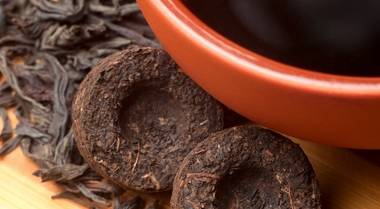ALL ABOUT PUERH: Shou and Sheng
November 29, 2024
by Diana Rosen

Originating in China’s Yunnan Province, and defined by its geographical region in or around the city of Puer, the tea’s names in pinyin vary in spelling: pu’er, pu-er, puerh, puer. Rarely, the ancient names are used: bolay/po lei.
Puerh is processed either as loose leaf or compressed into shapes like rectangular bricks (zhuan cha) or round cakes (bing cha) or in fanciful ones like large bowls or reflecting nature like tiny hummingbird’s nests (tuo cha).
These shapes were first used during the era of the Silk Road trading routes when the length of such trips required a way to preserve the tea so that it would still be useable at every stop along the way. In addition, the bricks were used as currency or for trading for salt or spices or silks and other goods. They’re often still decorated with images that make them as beautiful to look at as they are delicious to drink.
RAW OR RIPE
One other distinctive characteristic of puerh is whether it’s raw (Sheng) or ripe (Shou.)
Production of any puerh begins with raw green tea leaves from either wild or cultivated tea bushes. In ripe (Shou) puerh production, the leaves are pan fired, rolled, and sun dried and go through a pile fermentation processing (distinct from oxidation) that is accelerated over a relatively short time, six to eight weeks. This protocol may be referred to as “cooked.” After these steps, it reaches the mao cha or rough tea stage and the leaves are either sold as is or compressed into various shapes for sale.
The raw (Sheng) puerh leaves are produced in the traditional style. After reaching the mao cha stage, the leaves shaped into forms and stored in cool areas, often caves, for several decades. They’re rotated regularly to achieve uniform aging. This allows for enzyme activity that causes the tea leaves to expand and contract both absorbing and releasing moisture so that the tea leaves release their natural juices. Both this enzymic activity, and the intentional aging, help to develop the healthful bacteria that makes the raw (Sheng) puerh such a satisfying tea choice for easy digestion. The other advantage is the flavor, which is more pronounced, earthier (like mushrooms) and smooth enough to avoid any astringency.
HOW TO BREW
All puerh should be rinsed before brewing by pouring hot water over the leaves in your vessel then discarding that water after 5-10 seconds. This step awakens the leaves, removes the fannings or dust, and prepares the leaves for brewing fully.
Use a puerh knife to carve out a small quantity from a brick or cake or use a rounded teaspoon or 3-4 grams of dry loose leaves per cup. To brew in Yixing vessels, use one solely dedicated to puerh.
Raw (Sheng) puerhs should be brewed lightly like a green tea, at 195°F. for 2-3 minutes.
For ripe (Shou) selections, brew with water up to 200°F. for 2-3 minutes; older ones benefit from boiling water, 212°F. brewed up to 3 minutes.
As always, adjust quantities, temperatures, and time to suit your palate. The higher the temperature and the longer the brew, the stronger the taste which many puerh lovers prefer. Several re-infusions are typical in both categories of puerhs.
Brewing a gaiwan is slightly different. The rinsing should be about 5 seconds, and the first steeping 15-30 seconds or longer to taste. Use only 1 gram of tea per oz. of water because of the smaller size of the vessel. Repeat infusions work well.
FOR YOUR CONSIDERATION:
ANCIENT TREE GREEN PUERH, a raw (Sheng) puerh offers long, silvery buds and young leaves and an aroma in the dry leaf rich with fruit and earth. The medium-light amber infusion is silky smooth with hints of honey, apricot, a soft sweet smoke. Layered and lingering.
Grown at 800 meters above sea level, this big leaf cultivar consists of one bud and 2-3, 15-20 cm long leaves. After going through a10-minute firing, it is roasted for 5-6 hours at around 70°C. (158°F.) Medium caffeine. Steep at 195°F. for 2-3 minutes.
GONG TING (Palace Puerh) is a ripe (Shou) puerh of the highest quality. The dry leaves offer a slightly pungent anise-like sweetness with hints of the deep forest. The sublime, layered liquor is silky, smooth, mellow, with echoes of mineral and maybe plum.
Grown at an elevation of 1500-2200 meters above sea level, the leaves are hand-plucked from 20-year-old Yunnan Kang No. 10 trees from an arbor species and its golden buds are aged for two years. High caffeine. Steep at boiling, 212°F., for 3 minutes.
